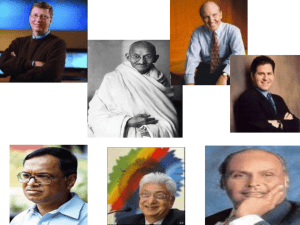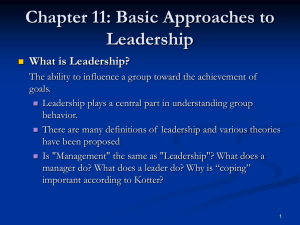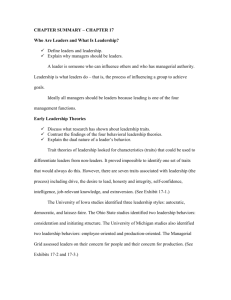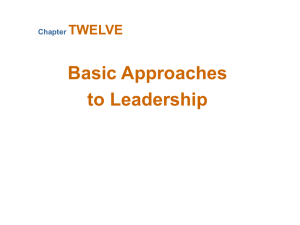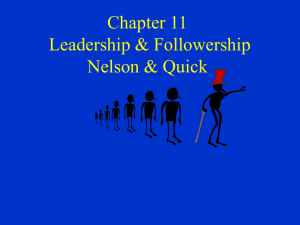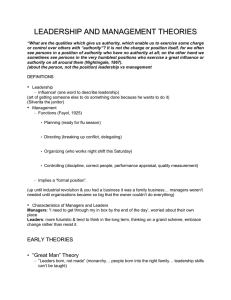session 6 7leadership 2 parts
advertisement
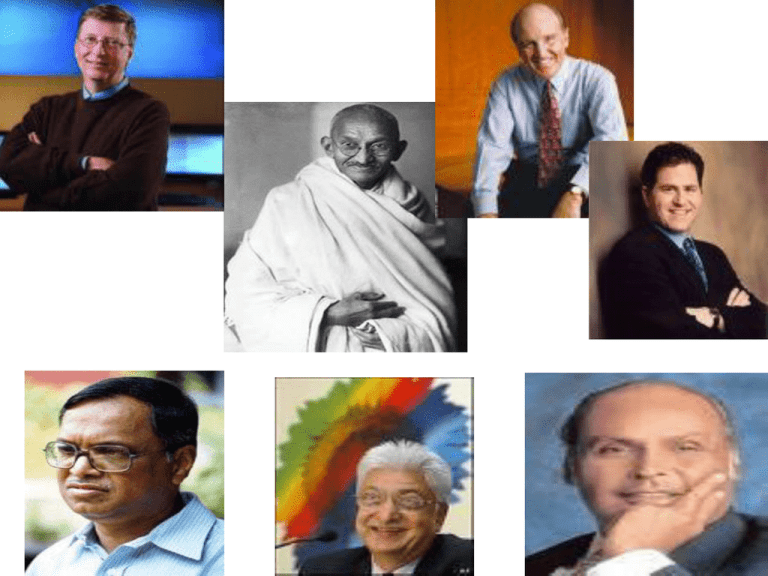
Leadership is the capacity to translate vision into reality Warren Bennis What Is Leadership? Leadership The ability to influence a group toward the achievement of goals. Management Use of authority inherent in designated formal rank to obtain compliance from organizational members. Trait Theories Traits Theories of Leadership Leadership Traits: Theories that consider personal qualities & characteristics that , differentiate leaders from nonleaders. • Ambition and energy The search for personality, social, physical or intellectual attributes that describe leaders from non leaders. • Intelligence • The desire to lead • Honest and integrity • Self-confidence • High self-monitoring • Job-relevant knowledge Trait Theories Assumptions People are born with inherited traits. Some traits are particularly suited to leadership. People who make good leaders have the right (or sufficient) combination of traits. Limitations: • No universal traits found that predict leadership in all situations. • Better predictor of the appearance of leadership than distinguishing effective and ineffective leaders. For a long period, inherited traits were sidelined as learned and situational factors were considered to be far more realistic as reasons for people acquiring leadership positions. Behavioral Theories Behavioral Theories of Leadership Theories proposing that specific behaviors differentiate leaders from nonleaders. • Trait theory: Leaders are born, not made. • Behavioral theory: Leadership traits can be taught. Ohio State Studies 1940s • Researchers sought to identify 1000 dimensions of leader behaviour which they narrowed down the list to two categories • They called the dimensions as initiating structure and consideration • Initiating structure – the extent to which the a leader is likely to define and structure his or her role and those of subordinates in the search for goal attainment. • Consideration – the extent to which a person is likely to have job relationships that are characterized by mutual trust, respect for employees as equals. University of Michigan Studies Employee-Oriented Leader Emphasizing interpersonal relations Taking a personal interest in the needs of employees and accepting individual differences among members. The research strongly favoured leaders who were employee oriented in their behaviour. Therefore higher productivity and higher job satisfaction Production-Oriented Leader One who emphasizes technical or task aspects of the job. Low productivity and lower job satisfaction The Managerial Grid (Blake and Mouton) E X H I B I T 11–1 The Managerial Grid High 9 Concern for people 8 9,9 Team management Work accomplishment is from committed people, interdependence through a “common stake” in organization purpose leads to relationship of trust and respect 1,9 Country club management Thoughtful attention needs of people for satisfying relationships leads to A comfortable, friendly organization atmosphere and work tempo 7 6 5 4 3 2 Low 1 5,5 Organization Man Management Adequate organization performance possible through balancing the necessity to get out work with maintaining morale of the people at a satisfactory level 9,1 1,1 Authority-Obedience Impoverished Management Efficiency in operations results Exertion of minimum effort to get from arranging conditions of required work done is appropriate work in such a way that human to sustain organization membership elements interfere to a minimal degree 1 Low 2 3 4 5 6 Concern for production 7 8 9 High Scandinavian Studies • Researchers in Finland and Sweden began reassessing whether there are only two dimensions that capture the essence of leadership behaviour. • Their basic premise is that in a changing world effective leaders would exhibit development oriented behaviour • Considering the earlier approaches these researchers felt that this dimension existed and is necessary in 21 st century. Contingency Theories Fiedler’s Contingency Model The theory that effective groups depend on a proper match between a leader’s style of interacting with subordinates and the degree to which the situation gives control and influence to the leader. Least Preferred Co-Worker (LPC) Questionnaire An instrument that purports to measure whether a person is task- or relationship-oriented. Fiedler’s Model: Defining the Situation Leader-Member Relations The degree of confidence, trust, and respect subordinates have in their leader. Task Structure The degree to which the job assignments are procedurized. Position Power Influence derived from one’s formal structural position in the organization; includes power to hire, fire, discipline, promote, and give salary increases. Findings from Fiedler Model E X H I B I T 11–2 Message By Jack Francis Welch “If you pick the right people and give them the opportunity to spread their wings and put compensation as a career behind it almost don’t have to manage it” “If you don’t have competitive advantage, don’t compete” “Control your own destiny or someone else will” Difference between leaders & Managers Leaders Managers Innovate Administer Develop Maintain Inspire Control Long Term View Short term view Ask what and why Ask, how and when Originate Initiate Challenge the status quo Accept the status quo Do the right things Do Things right Different Styles of Leadership • Autocratic leadership • Bureaucratic leadership • Charismatic leadership • Democratic leadership or Participative leadership • Laissez-faire leadership • People-oriented leadership or RelationsOriented leadership • Servant leadership • Task-oriented leadership • Transactional leadership • Transformational leadership Charismatic Leadership Key Characteristics of Charismatic leaders 1. Self Confidence- They have complete confidence in their judgment and ability. 2. A vision- This is an idealized goal that proposes a future better than the status quo. The greater the disparity between idealized goal and the status quo, the more likely that followers will attribute extraordinary vision to the leader. 3. Ability to articulate the vision- They are able to clarify and state the vision in terms that are understandable to others. This articulation demonstrates an understanding of the followers’ needs and, hence acts as a motivating force. 4. Strong convictions about vision- Charismatic leaders are perceived as being strongly committed, and willing to take on high personal risk, incur high costs, and engage in self-sacrifice to achieve their vision. 5. Behavior that is out of the ordinary- Those with charisma engage in behavior that is perceived as being novel, unconventional, and counter to norms. When successful , these behaviors evoke surprise and admiration in followers. 6. Perceived as being a change agent- Charismatic leaders are perceived as agents of radical change rather than as caretakers of the status quo. 7. Environmental sensitivity- These leaders are able to make realistic assessments of the environmental constraints and resources needed to bring about change. Transactional vs Transformational leaders Characteristics of Transactional and transformational leaders Transactional Leaders • • • • Contingent Reward: Contracts exchange of rewards for effort, promises rewards for good performance, recognizes accomplishment Management by exception (active): Watches and searches for deviations from rules and standards, takes corrective action. Management by exception (passive): Intervenes only if standards are not met Laissez faire: Abdicates responsibilities, avoids making decisions Transformational Leaders • • • • Charisma : Provides vision and sense of mission, instills pride, gains respect trust. Inspiration: Communicates high expectations, uses symbols to focus efforts, expresses important purposes in simple ways. Intellectual Stimulations: Promotes intelligence, rationality, and careful problem solving. Individualized consideration: Gives personal attention, treats each employee individually, coaches, advises. • • • • • • Traits of Exceptional Leaders An outside in perspective – Eg Dell computer which puts the customer at the very center An evangelical leadership gene Eg – Lou Gerstner IBM had this trait in shifting companies mindset he was intensely focused on restoring outside in perspective Understands the critical role of culture Eg- Michael Dell had the performance oriented culture suggesting that if you don’t perform at Dell go somewhere else Eg- Sam Walton had family oriented culture in Wal Mart Creates next generation products , processes or solutions EGThis is in alignment with the vision, Bill Gates had anticipated the market for software , Sam Walton realized the tremendous potential of Walmart in 1962 Implements the best ideas regardless of origin Eg Sam Walton ,went into the competitors stores to emulate the best practices, IBM &GE ran into the trouble when their managers stopped searching outside the company for answers Advances the leadership body of knowledge MODELS OF LEADERSHIPCHANGE - CHARISMA TO BUSINESS LEADERS – FORMAL Vs MORAL AUTHORITY MATRIX High + + Hitler Position + George Washington + Man Mohan (Formal Authority) - - Many Celebrities Low ( Stephen Covey ) - Mahatma Gandhi CHOICE (Moral Authority) High + MODELS OF LEADERSHIP (NATIONAL & CORPORATE) ‘Man Mohan – Murthy’ Gentle,Firm,Relentless Humble,Ethical, Moral authority,Discipline Progressive,Professional Sensitive, Principled Vs ‘Bush – Blair’ Bluff, Boldness, Brashness, Vendetta, Arrogance, Insensitivity, Resourcefulness Courage,Maneavouring POA • Popular concept of viewing leaders as coaches. • Visit http://www.coachu.com- an organization specializes in training coaches as managers. • Look at international coaching federation http://www.coachfederation.com find out the answers • Would you like to be led by a coach as these organizations define. What would be the advantages and disadvantages of viewing leaders this way ? • Based on your own leadership style, would you make a good coach ? Why or why not ? • Discuss a situation in which a coaching approach to leadership is particularly effective. What would be a situation where a coaching approach would seem to be ineffective ? Small - Case Study Cognitive Resource Theory Cognitive Resource Theory- reconceptualized by Fiedler Joe Garcia A theory of leadership that states that stress can unfavorably affect a situation and that intelligence and experience can lessen the influence of stress on the leader. Research Support: • Less intelligent individuals perform better in leadership roles under high stress than do more intelligent individuals. • Less experienced people perform better in leadership roles under low stress than do more experienced people. Hersey and Blanchard’s Situational Leadership Theory Situational Leadership Theory (SLT) A contingency theory that focuses on followers’ readiness. Unable and Unwilling Unable but Willing Able and Unwilling Able and Willing Follower readiness: ability and willingness Leader: decreasing need for support and supervision Directive High Task and Relationship Orientations Supportive Participative Monitoring Leadership Styles and Follower Readiness (Hersey and Blanchard) Follower Readiness Able Supportive Participative Monitoring Leadership Styles Unable Directive Unwilling High Task and Relationship Orientations Willing Leader–Member Exchange Theory Leader-Member Exchange (LMX) Theory Leaders create in-groups and out-groups, and subordinates with in-group status will have higher performance ratings, less turnover, and greater job satisfaction. Leader-Member Exchange Theory Path-Goal Theory Path-Goal Theory The theory that it is the leader’s job to assist followers in attaining their goals and to provide them the necessary direction and/or support to ensure that their goals are compatible with the overall objectives of the group or organization. The Path-Goal Theory E X H I B I T 11–4 Leader-Participation Model Leader-Participation Model (Vroom and Yetton) A leadership theory that provides a set of rules to determine the form and amount of participative decision making in different situations. It was a decision tree having 7 contingency variables with 5 leadership styles. The leadership model is now revised to 11 contingency variables. The model however, fails to have stress, Intelligence and experience in this. Contingency Variables in the Revised Leader-Participation Model 1. 2. 3. 4. 5. 6. 7. 8. 9. 10. 11. 12. Importance of the decision Importance of obtaining follower commitment to the decision Whether the leader has sufficient information to make a good decision How well structured the problem is Whether an autocratic decision would receive follower commitment Whether followers “buy into” the organization’s goals Whether there is likely to be conflict among followers over solution alternatives Whether followers have the necessary information to make a good decision Time constraints on the leader that may limit follower involvement Whether costs to bring geographically dispersed members together is justified Importance to the leader of minimizing the time it takes to make the decision Importance of using participation as a tool for developing follower decision skills Deeds for leaders • Vivah or marriage – between the king & kingdom (leader and organization ).In the absence of this a man is not a leader just an employee doing a job that gives him salary and status. Don’t expect him to be proactive ,creative or enthusiastic • Rajsuya – One has to prove tangible achievement and has to be accepted by peer group. • Abhishek – public bathing was transformational ritual Eg- a field sales manager sent to his headquarters without any attempt by the management to ceremonially crown him king in front of those he is supposed to manage »Article from corporate doisser Deeds for leaders • Dharma – his vision and how he expects to achieve or realise this vision. • Varna – station in the organization and ashrama or stage in the employee • Varana –dharma – means defining the roles and rights and the responsibilities of every employee • Ashrama –dharma – knowing which member of the organization is in which stage of his job or his career – learning stage or retiring stage Deeds for Leaders • Ashwamedh yagna – this helped the kind identify who submitted themselves to him and who challenged • Eg- PPT- horse, excel sheet with all the search data justifying the nos –army, • Digvijay means conquest of the sky or the directions. In corporate world the king must travel through different departments and ensure he is seen and heard and to assert his authority and to tell where he plans to go from here. • Vajpeya - a yagna of regeneration. To make the head roll to tell the world who is the boss
